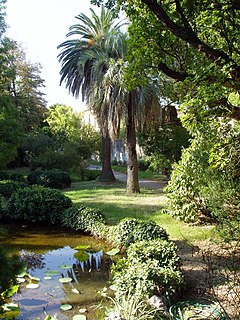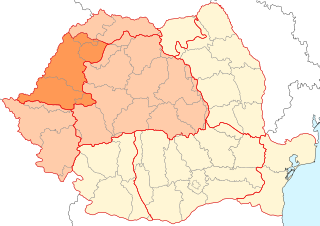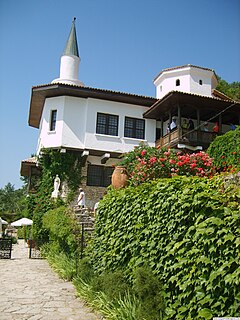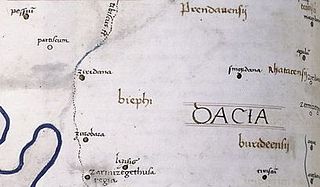Related Research Articles

A botanical garden or botanic garden is a garden dedicated to the collection, cultivation, preservation and display of a wide range of plants labelled with their botanical names. It may contain specialist plant collections such as cacti and other succulent plants, herb gardens, plants from particular parts of the world, and so on; there may be greenhouses, shadehouses, again with special collections such as tropical plants, alpine plants, or other exotic plants. Visitor services at a botanical garden might include tours, educational displays, art exhibitions, book rooms, open-air theatrical and musical performances, and other entertainment.

Arad County is an administrative division (judeţ) of Romania roughly translated into county in the western part of the country on the border with Hungary, mostly in the region of Crișana and few villages in Banat. The administrative center of the county lies in the city of Arad. The Arad County is part of the Danube–Criș–Mureș–Tisa Euroregion.

Crișana is a geographical and historical region in north-western Romania, named after the Criș (Körös) River and its three tributaries: the Crișul Alb, Crișul Negru, and Crișul Repede. In Romania, the term is sometimes extended to included areas beyond the border, in Hungary; in this interpretation, the region is bounded to the east by the Apuseni Mountains, to the south by the Mureș River, to the north by the Someș River, and to the west by the Tisza River, the Romanian-Hungarian border cutting it in two. However, in Hungary, the area between the Tisza River and the Romanian border is usually known as Tiszántúl.

The Cluj-Napoca Botanical Garden, officially Alexandru Borza Cluj-Napoca University Botanic Garden, is a botanical garden located in the south part of Cluj-Napoca, Romania. It was founded in 1872 by Hungarian linguist Sámuel Brassai, known as the "Last Transylvanian Polymath". Its director in 1905 was Aladár Richter, then Páter Béla, Győrffy István, and then, in 1920, it was taken over by the local university and by Alexandru Borza.

The Royal Botanic Garden Edinburgh (RBGE) is a scientific centre for the study of plants, their diversity and conservation, as well as a popular tourist attraction. Founded in 1670 as a physic garden to grow medicinal plants, today it occupies four sites across Scotland—Edinburgh, Dawyck, Logan and Benmore—each with its own specialist collection. The RBGE's living collection consists of more than 13,302 plant species, whilst the herbarium contains in excess of 3 million preserved specimens.

The Royal Botanic Garden, Sydney is a heritage-listed major 30-hectare (74-acre) botanical garden, event venue and public recreation area located at Farm Cove on the eastern fringe of the Sydney central business district, in the City of Sydney local government area of New South Wales, Australia.

The Balchik Palace is a palace in the Bulgarian Black Sea town and resort of Balchik in Southern Dobruja. The official name of the palace was the Quiet Nest Palace. It was constructed between 1926 and 1937, during the Romanian control of the region, for the needs of Queen Marie of Romania. The palace complex consists of a number of residential villas, a smoking hall, a wine cellar, a power station, a monastery, a holy spring, a chapel and many other buildings, as well as most notably a park that is today a state-run botanical garden. Balchik Palace is 17 metres (56 ft) above sea level.

Bârzava is a commune in Arad County, Romania. The commune Bârzava is situated at the foot of Zărand Mountains, at its contact point with Metaliferi Mountains, along the river Bârzava - a right tributary of the Mureș. It is composed of eight villages: Bârzava, Bătuța (Battuca), Căpruța (Kapruca), Dumbrăvița (Alsódombró), Groșii Noi (Garassa), Lalașinț (Lalánc), Monoroștia (Marosmonyoró) and Slatina de Mureș (Marosszlatina).

Beliu is a commune in Arad County, Romania. Beliu commune lies in the contact zone of Teuzului Plateau with Mărăușului Hills, along the Beliu River. It is composed of six villages: Beliu, Benești (Benyefalva), Bochia (Boklya), Vasile Goldiș, Secaci (Felsőszakács) and Tăgădău (Tagadómedgyes). Its territory is 3695 ha.

Marcel Coraș is a retired Romanian football striker.

„Vasile Goldiș” Western University of Arad is a private university located in Arad, Romania.

Macea is a commune in Arad County, Romania, composed of two villages, Macea and Sânmartin. It is located 23 km from Arad and 6 km from Curtici.

Zădăreni is a commune in Arad County, Romania, is situated in the northern part of the Vinga Plateau, along the Mureș valley. Its territory occupies 2145 hectares. It is composed of two villages: Bodrogu Nou (Újbodrog) and Zădăreni. These were part of Felnac Commune until 2004, when they were split off.

The Iași Botanical Garden, now named after its founder, Anastasie Fătu, is a botanical garden located in the Copou neighbourhood of Iași, Romania. Established in the year 1856 and maintained by the Alexandru Ioan Cuza University, it is the oldest and largest botanical garden in Romania.

Arad is the capital city of Arad County, historically situated in the region of Crișana, and having extended into the neighboring Banat region in the 20th century. Arad is the third largest city in Western Romania, behind Timișoara and Oradea, and the 12th largest in Romania, with a population of 159,704.
The Arad Museum Complex is primarily a history and archaeology museum in the city of Arad, Romania.

Ziridava was a Dacian town located between Apulon and Tibiscum, mentioned by Ptolemy in the area of the Dacian tribe of Biephi.

The State Herbarium of South Australia is located in Adelaide, South Australia. It is one of several State and Commonwealth herbaria in Australia. The Department for Environment and Water is the state agency which is responsible for the Herbarium, but the Board of the Botanic Gardens and State Herbarium is charged with its establishment and maintenance.

The Field Elm cultivar Ulmus minor 'Suberosa', commonly known as the Cork-barked elm, is a slow-growing or dwarf form of conspicuously suberose Field Elm. Of disputed status, it is considered a distinct variety by some botanists, among them Henry (1913), Krüssmann (1984), and Bean (1988), and is sometimes cloned and planted as a cultivar. Henry said the tree "appears to be a common variety in the forests of central Europe", Bean noting that it "occurs in dry habitats". By the proposed rule that known or suspected clones of U. minor, once cultivated and named, should be treated as cultivars, the tree would be designated U. minor 'Suberosa'. The Späth nursery of Berlin distributed an U. campestris suberosa alataKirchn. [:'corky-winged'] from the 1890s to the 1930s.